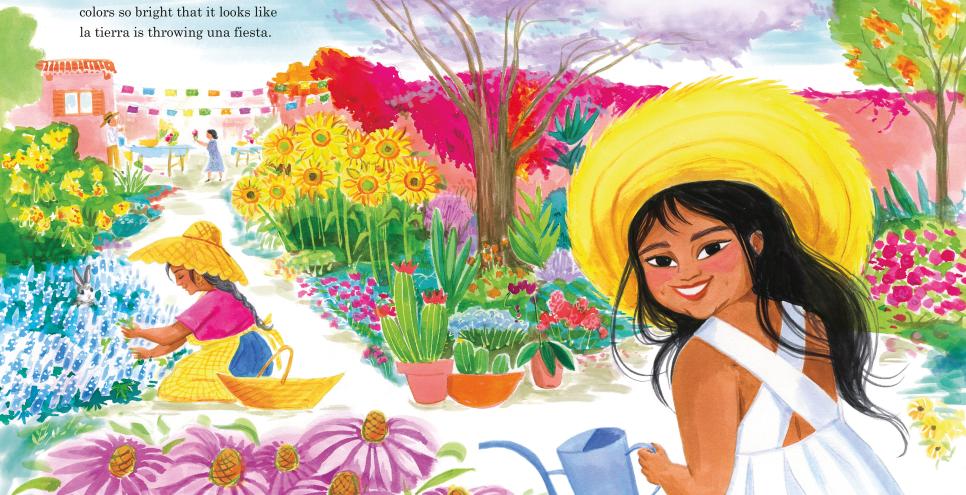Sprouting Stories: A Reading Library Exhibition
Across the Earth, plants spring up and put down roots in all types of settings and ecosystems—from forests and fields to the cracks in a city sidewalk. Although plants are often overlooked as members of communities, they are creative, resourceful, and resilient, just like people, and lead interconnected lives with humans and the other creatures that surround them.
There is so much to be learned from recognizing and sharing the ways plants show up in our lives and communities. Having spent many years studying as an herbalist and working as a farmer and in the food industry, I am deeply grateful to the plants I’ve worked with and met, and for the multiplicity of ways I have been able to spend time with plants. Cooking, weeding, gardening, making tea, or savoring the shade offered by a tree—these are only a few examples of the rich variety of human-plant interaction to celebrate.
There is no one way, or right way, to spend time with the plants around us. The more we share our many stories of plants, the more we may imagine the possibilities of coexisting with both the plants and people that share our planet. New stories and new relationships may sprout from the connections we make with one another and with the growing green life around us.
The City Tree by Shira Boss, illustrated by Lorena Alvarez, shares some of the many ways that people can spend time with their plant friends.
Image credit: The City Tree written by Shira Boss and illustrated by Lorena Alvarez (Clarion Books). Text © 2023 Shira Boss and illustrations © 2023 Lorena Alvarez.
Picture books offer a unique opportunity for authors and illustrators to center plants in stories that reach both adult and child audiences. The 45 books highlighted in the book exhibition Sprouting Stories: People & Plants in Picture Books, invite readers to think about their own engagement with plants, while also considering the ways plants show up in the varied lives of people and their cultures and communities. These books invite readers to think about the way they engage with plants, and the roles that other non-human creatures play in the experience of plants. The books also recognize that plants have lives and tales of their own and consider the ways plants show up in the lives of people and their cultures and communities. Finally, they also recognize how our imaginations can grow gardens of their own.
Growing Gardens
What is a garden and who do we find there? Gardens are common meeting grounds for people and plants and serve many purposes. No two gardens are the same! These titles present a variety of garden stories and celebrate the many ways gardens nurture relationships with self, plants, and wider communities. For example, the garden created by Jayden and Mr. Curtis in Jayden’s Impossible Garden by Mélina Mangal, illustrated by Ken Daley, brings beauty and wild creatures to the community, helping their neighbors to recognize the nature surrounding them. Meanwhile, Grace Lin’s The Ugly Vegetables tells the story of a girl’s changing feelings towards her mother’s garden of Chinese vegetables, when the “ugly vegetables” bring together her entire neighborhood for a delicious meal.
A group of Harlem students and their community come together to transform a vacant lot into a thriving garden in How One Big Idea Transformed a Neighborhood by Tony Hillery, illustrated by Jessie Hartland.
Image credit: How One Big Idea Transformed a Neighborhood written by Tony Hillery and illustrated by Jessie Hartland (Simon & Schuster Books for Young Readers). Text © 2020 Tony Hillery and illustrations © 2020 Jessie Hartland.
In the Garden!
Plants and humans aren’t the only ones that can be found in the garden. These stories highlight the ways other creatures spend time in gardens, whether it’s the curious backyard hen of Pat Hutchins’ Bumpety Bump!, the troublesome rabbits of author Candace Fleming’s and illustrator G. Brian Karas’ Muncha! Muncha! Muncha!, or the assortment of hungry critters in Kadir Nelson’s If You Plant a Seed.
In Pat Hutchin’s Bumpety Bump!, a curious hen insists on joining in the gardening fun.
Image credit: Bumpety Bump! written and illustrated by Pat Hutchins (Greenwillow Books). Text and illustration © 2006.
Imaginary Gardens
Not all gardens need soil and sunlight to grow. Sometimes gardens take shape on paper, like the garden drawn by Theo and her Poppa in The Imaginary Garden by Andrew Larsen, illustrated by Irene Luxbacher, or as sculpture, like Leo Lionni’s Imaginary Garden, on permanent display at The Carle. Other gardens may exist only in our dreams and wildest imaginings!
What would you grow in your dream garden? Googly eyes, teeth, and tentacles seem to be favorites for Millie Fleur in Millie Fleur’s Poison Garden by Christy Mandin.
Image credit: Millie Fleur’s Poison Garden written and illustrated by Christy Mandin (Orchard Books). Text and illustrations © 2024 Christy Mandin.
Plant Protagonists
Plants have their own stories to tell. In these picture books, plants are main characters with their own unique adventures, challenges, and relationships. Lemniscates’ Trees follows the seasonal cycle of trees and their experience of their surroundings, while Robin Page’s Seeds Move shows some of the creative ways that plants team up with other creatures and the world around them to spread their seeds. Other books, like The World’s Best Class Plant by Liz Garton Scanlon and Audrey Vernick, illustrated by Lynnor Bontigao, and The City Tree, by Shira Boss, illustrated by Lorena Alvarez, tell the stories of plants and people who forge deep personal connections with one another.
Snuggling with bees and sharing their seeds, Weeds find a Way by Cindy Jenson-Elliott and illustrated by Carolyn Fisher, reminds us that plants too lead busy lives.
Image credit: Weeds Find a Way written by Cindy Jenson-Elliott and illustrated by Carolyn Fisher (Beach Lane Books). Text © 2014 Cynthia Jenson-Elliott and illustrations © 2014 Carolyn Fisher.
Rooted Stories
There are many ways that plants show up in lives and stories. The books included in this section consider how plants can play important roles in supporting personal connections to culture and identity, helping people work through emotions and experiences, and develop relationships with the natural world. In A Crown for Corina, author Laekan Zea Kemp and illustrator Elisa Chavarri tell the story of Corina Casarez, a young girl who creates a flower crown from her Abuela’s garden, rooting her to her family and her history. In Fresh Juice by Robert Liu-Trujillo, Art and his father set out on a search for fresh ginger for cold-fighting juice. Journeying from the farmer’s market to the food co-op to the West African grocery store, they find a wide range of delicious ingredients provided by a supportive and knowledgeable community. Rough Patch, by Brian Lies, explores the challenges of loss and grief, and the ways plants can help and bring comfort in difficult times.
There is a pine tree near my house that I visit whenever I go out for a walk. Taking the time to say hello and spend some time with this tree always feels like running into an old friend—we are busy with our own lives, but always have space for one another. Plants and people can grow, root, and thrive together, both in the pages of books and in our world. Are there any plants that have special meaning in your life?
In Nell Plants a Tree by Anne Wynter, illustrated by Daniel Miyares, a girl’s planting of a pecan tree creates a long-lasting and beautiful space for a loving, intergenerational Black family.
Image credit: Nell Plants a Tree written by Anne Wynter and illustrated by Daniel Miyares (Balzer + Bray). Text © 2023 Anne Wynter and illustrations © 2023 Daniel Miyares.


